If you make the Meyer lemon curd that I posted here, you’ll find yourself with a number of left over egg whites. Oh, what to do, what to do?!
The best part about that lemon curd recipe is it implores you to make a lemon meringue tart with the leftover egg whites. Isn’t that genius?!
Not that I really needed an excuse to make dessert.
Personally, I prefer this type of lemon meringue tart over the typical mile-high incarnations of lemon meringue pie. With this tart you’re not confronted with an enormous mass of whipped egg white on a plate, that bears a striking resemblance to the iceberg that sank the Titanic, with a nearly absent lemon layer, and a disappointingly soggy crust that you’re certain was thrown together as a last minute afterthought.
This tart has a delectably light, crisp, flaky pastry, a divine and balanced layer of just-tangy-enough Meyer lemon curd, and a sweet, melt-in-your-mouth, layer of meringue.
See, now you want a slice, don’t you? I thought so. So, who am I to stand between you and the perfect lemony dessert? Without further ado, here’s our recipe for a flavorful, elegant, Meyer lemon meringue tart, that is guaranteed to tickle your taste buds.
Meyer Lemon Meringue Tart
Ingredients:
The Curd
1-1/4 Cups Meyer Lemon Curd
The Pâte Brisée
1-1/2 Cups Unbleached All Purpose Flour
1/4 Tsp Salt
1-1/2 Tsp Granulated Sugar
10 Tbsp Cold Unsalted Butter, cut into 1/2 cubes
1/3 Cup Ice-Cold Water
The Meringue
1/2 Liquid Cup (4 fl oz) Egg Whites, at Room Temperature
1/2 Tsp Cream of Tartar
3/4 Cup Superfine Sugar*
*Superfine sugar is NOT the same thing as powdered or icing sugar! It is a finely granulated sugar, sometimes sold as ‘baking sugar’. If you don’t have superfine sugar to hand, put 3/4 cup of regular granulated sugar in the bowl of your food processor, with the metal cutting blade attached, and process for 2-3 minutes.
Equipment
Food Processor with Metal Cutting Blade
Stand Mixer with Wire Whip Attachment
Rectangular Tart Pan 13 3/4″ x 4 1/2″ x 1″ high, with removable bottom
Rolling Pin
Silicone Spatula
Piping bag (or ziptop bag) with a number 18 Star Tip (Optional)
Instructions:
First, prepare the Meyer lemon curd, as the curd should be cool, and well set before filling the tart shell. I recommend making the curd the day before, and refrigerating it overnight.
Pâte Brisée (Pastry)
Preheat the oven to 425F.
Put the flour, salt, sugar, and cubed butter into the food processor fitted with the metal cutting blade. Process for five 1-second pulses to evenly distribute the butter through the flour.
Add the ice-cold water, and pulse for an additional 10-12 seconds, just until the dough begins to come to together. Turn the dough out into a medium bowl, shape into a ball, and wrap tightly with plastic wrap. Refrigerate the dough for at least 20 minutes before rolling.
Prepare the tart pan by coating it well with very soft, not quite melted, butter. I use a pastry brush to push the butter into the fluted areas of the pan. Don’t use melted better, as it will slide down the sides, and run through the bottom of the pan.
Once chilled, and rested, shape the dough into a rough rectangle, and roll the dough into an 18×9-inch rectangle, approximately 3/8-inch thick.
Lay the dough across the pan, and gently press it into the base and sides of the pan. If you lay the dough over the tart pan edges, you can quickly trim the excess with one swipe of your rolling pin.
Set the tart pan on a baking sheet to make it easier to handle, and dock the pastry with a fork, to prevent the pastry puffing up while baking.
Line the dough with a sheet of parchment, and using pie weights, or dry beans, blind bake the tart dough at 425 degrees for 20 minutes. Remove the pie weights, and parchment, and bake for 8-10 minutes more, or until the dough is golden. Recheck the dough every few minutes, and if the pastry begins to puff once the pie weights are removed, dock the dough again to allow heat and moisture to escape.
Set the tart shell aside to cool, but do not remove it from the tart pan.
Reduce the oven temperature to 300F.
Assembling The Tart
Lemon Curd
Spread the lemon curd evenly across the prepared tart shell and bake in a 300F oven for 10 minutes. The lemon curd should NOT brown, but shouldn’t jiggle excessively when the pan is moved.
Set the tart aside to cool. The curd needs to cool and firm before adding the meringue layer.
Meringue
Increase the oven temperature to 500F
Once the curd has cooled, in the bowl of your stand mixer, fitted with the wire whip, beat the egg whites until they’re foamy.
Add the cream of tartar, and beat the egg whites at medium speed while you gradually add 2 tablespoons of sugar. Once you reach the soft peak stage, slowly add the remainder of the sugar, and continue beating until you reach stiff peaks.
Your meringue has reached the stiff peak stage when you tip the whisk upside down, and the ‘peak’ does not fall over, as shown below. The egg white should still have a glossy appearance.
Don’t over-whip, or the egg whites will dull, and you’ll break the meringue.
Carefully spread an even layer of the meringue across the top of the curd with a flat silicone spatula so that it’s even with the edge of the crust. Be careful not to pull up the lemon curd with the meringue. I find it’s easier to start at the edge of the crust, and work toward the center of the tart.
Once this first layer is down, you can add a little more meringue to the surface of the tart to pull into peaks if you wish, or alternatively, if you want to impress your friends, you can make a meringue lattice as we did here.
To make the lattice, fill a pastry bag fitted with a #18 star tip with the remaining meringue.
Position the tart with its length running from left to right in front of you. Starting in the center of the tart, pipe the meringue, left to right, in thin lines, 1/4″ apart from the center to the edge of the tart. Rotate the tart pan 180 degrees, and repeat, joining with the lines already piped on the tart. Don’t worry about perfectly connecting the center points.
Turn the tart 90 degrees, so the length of the tart is facing away from you, and starting at the center, so you hide any irregularity where you joined the lines, pipe perpendicular lines across the entire tart surface. I start at the center, and work toward me, rotate 180 degrees, and repeat.
To prevent the meringue from pulling away from the crust during baking, pipe a small border of meringue all the way around the edge of the tart.
Bake the tart in a 500F oven for 4-6 minutes, or until golden brown. Watch it very closely though, so the sugar in the meringue doesn’t burn.
Now sit on your hands, make dinner, or walk the dog, for at least an hour, until the tart has cooled. DO NOT CUT INTO THE TART WHILE WARM.
Now the tart is cool, carefully unmold the tart, and using a wet knife blade, slice, and serve. Make sure to clean and re-wet the knife blade between slices to prevent tearing the meringue.
Now ask yourself, why didn’t you make this sooner?!
The tart, ideally, should be eaten the same day.
Any leftover tart should be stored in the refrigerator for up to 24 hours, but I seriously doubt there will be any leftovers. Enjoy!


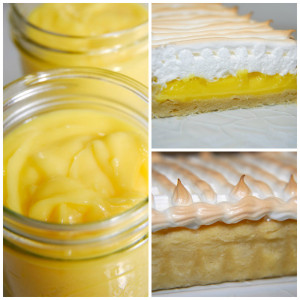
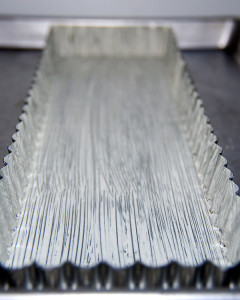
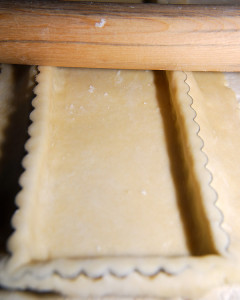
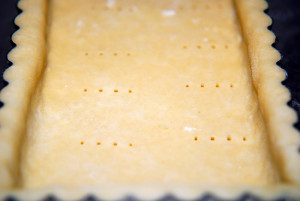
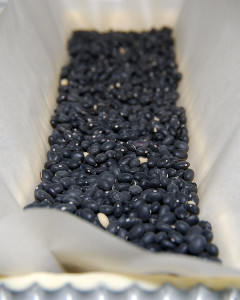
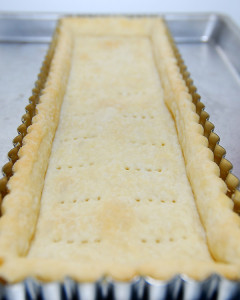
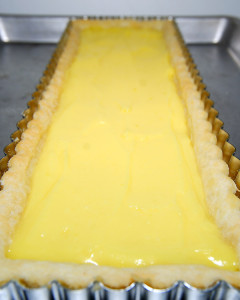


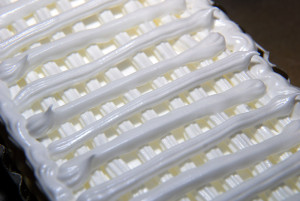


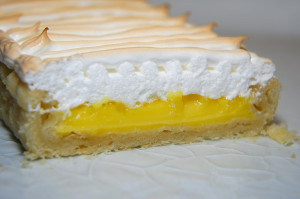
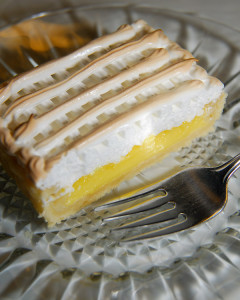







I love this use of the lemon curd…luscious indeed.
It had been years since I’d made a meringue, but I have to say, I’m very glad I did! It was delicious 😉
This tart looks as beautiful as it is delicious no doubt. I’ve never made lemon curd (Can’t believe I put that in writing)but I will now. Clare, I’ll quit asking when you sleep, because I think I already know the answer: never. Here’s to your gifts and talents and your generous nature in sharing them with your friends and mere mortals. You’re inspiring.
Aw, thanks Tom. I do sleep, honest! Trust me, I’m supremely grumpy without at least 7 hours of sleep a night 😛
I’m not a big fan of lemon meringue … long story about why. But that dessert looks yummy even to me! I think I would substitute chocolate meringue. 😉
I’m not a huge fan either, at least not of the traditional lemon meringue pies. They’re just too much. I did enjoy this though, as it was very flavorful, but not at all overwhelming. I must admit, chocolate meringue doesn’t sound bad either though 😉
That looks so incredibly delicious you’re making me hungry! Are you a chef AND a biologist?
I am a biologist…but a chef? Nooooo. I do love to cook though, and my grandparents owned a bakery, so my love of baking might be genetic 😉 I do have a passion for eating good, flavorful, food. I definitely believe that life’s too short to eat bad food!
This looks fantastic. Lemon meringue pie has always been among my favorite desserts. It makes me sad when it is done badly. I have never seen the meringue done as a lattice; this elevates the dessert to something very special!
I agree, a poorly constructed lemon meringue is nothing short of an assault on the senses. I loved doing the lattice on this. It only took a few extra minutes, but it’s a fun, slightly different twist, on your typical meringue 🙂